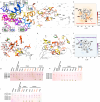Mechanistic studies of mycobacterial glycolipid biosynthesis by the mannosyltransferase PimE
- PMID: 40301322
- PMCID: PMC12041525
- DOI: 10.1038/s41467-025-57843-1
Mechanistic studies of mycobacterial glycolipid biosynthesis by the mannosyltransferase PimE
Abstract
Tuberculosis (TB), a leading cause of death among infectious diseases globally, is caused by Mycobacterium tuberculosis (Mtb). The pathogenicity of Mtb is largely attributed to its complex cell envelope, which includes a class of glycolipids called phosphatidyl-myo-inositol mannosides (PIMs). These glycolipids maintain the integrity of the cell envelope, regulate permeability, and mediate host-pathogen interactions. PIMs comprise a phosphatidyl-myo-inositol core decorated with one to six mannose residues and up to four acyl chains. The mannosyltransferase PimE catalyzes the transfer of the fifth PIM mannose residue from a polyprenyl phosphate-mannose (PPM) donor. This step contributes to the proper assembly and function of the mycobacterial cell envelope; however, the structural basis for substrate recognition and the catalytic mechanism of PimE remain poorly understood. Here, we present the cryo-electron microscopy (cryo-EM) structures of PimE from Mycobacterium abscessus in its apo and product-bound form. The structures reveal a distinctive binding cavity that accommodates both donor and acceptor substrates/products. Key residues involved in substrate coordination and catalysis were identified and validated via in vitro assays and in vivo complementation, while molecular dynamics simulations delineated access pathways and binding dynamics. Our integrated approach provides comprehensive insights into PimE function and informs potential strategies for anti-TB therapeutics.
© 2025. The Author(s).
Conflict of interest statement
Competing interests: The authors declare no competing interests.
Figures





Update of
-
Mechanistic studies of mycobacterial glycolipid biosynthesis by the mannosyltransferase PimE.bioRxiv [Preprint]. 2024 Sep 18:2024.09.17.613550. doi: 10.1101/2024.09.17.613550. bioRxiv. 2024. Update in: Nat Commun. 2025 Apr 29;16(1):3974. doi: 10.1038/s41467-025-57843-1. PMID: 39345506 Free PMC article. Updated. Preprint.
References
-
- Daniel, T. M. The history of tuberculosis. Respir. Med.100, 1862–1870 (2006). - PubMed
-
- World Health Organization. 2024 Global Tuberculosis Report (WHO, 2024).
-
- Cirillo, J. D. & Kong, Y. Tuberculosis Host-Pathogen Interactions (Springer International Publishing, 2019).
-
- McNeil, M. R. & Brennan, P. J. Structure, function and biogenesis of the cell envelope of mycobacteria in relation to bacterial physiology, pathogenesis and drug resistance; some thoughts and possibilities arising from recent structural information. Res. Microbiol.142, 451–463 (1991). - PubMed
MeSH terms
Substances
Grants and funding
LinkOut - more resources
Full Text Sources

